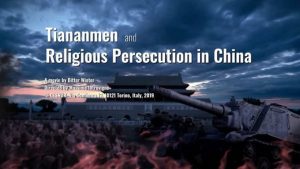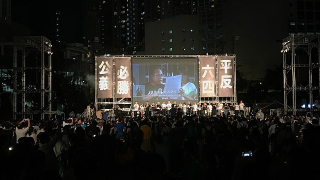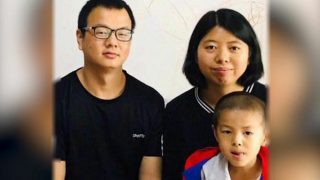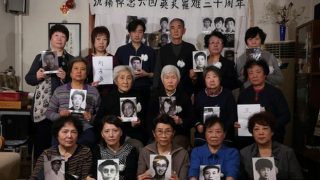June 4 commemorates Tiananmen. It is more than a memory. Persecution continues in China, and is even exported abroad through the harassment of refugees.
Massimo Introvigne
Every day, Bitter Winter gives voice to the voiceless, reporting about human rights in China. We remember today, June 4, 2019, what happened in Tiananmen Square in Beijing on June 4, 1989. It was a turning point. We focus on religious liberty. Beyond the bravery of the Tiananmen students, we investigate the relationship between Tiananmen and religious repression in China. Tiananmen is a memory, but religion repression continues.
When
Historians regard 1989 as one of the most decisive years in modern history. Communism collapsed in Eastern Europe, starting with mass demonstrations in Poland and Hungary, and later in Czechoslovakia and Romania. The Berlin Wall was opened in November. It was the end of an epoch.
On February 15, 1989, the Soviet troops left Afghanistan, acknowledging their inability to defeat local Muslim guerillas. It was an event of immense significance for both the Soviet Union and the Muslim world.
Protests in Lithuania led to the Baltic Way of August 23, 1989. Two million people joined hands and formed a human chain across the three Baltic states of Estonia, Latvia, and Lithuania, demanding the end of the Soviet occupation of their countries. It was the beginning of the end of the Soviet Union.
Although historians debate how really influential the Eastern European events were on China, they may have played a role on the widespread hopes that the former General Secretary of CCP, Hu Yaobang (1915–1989), who had been forced to resign in 1987 but remained popular, might play the same role as Mikhail Gorbachev in the Soviet Union, leading to reform.
However, on April 15, 1989, Chinese media announced that Hu, who was in good health, had died of a “sudden heart attack.” Many university students believed Hu had been killed, and started gathering in protest both in Tiananmen Square in Beijing and elsewhere in the country.
What
Students continued to gather, with occasional skirmishes with the police. Meanwhile, the CCP debated what to do. The 85-year old leader Deng Xiaoping (1904–1997) had still the last word on all crucial decisions. He ordered to publish an editorial on April 26 in the CCP’s People’s Daily declaring that the students were counter-revolutionaries and had to be stopped.
Contrary to CCP’s expectations, the editorial did not stop the Tiananmen protest. The students’ number grew to hundreds of thousands and on May 14 they started a hunger strike. Quarrels among CCP leaders became increasingly visible, with Party secretary Zhao Ziyang (1919–2005) favoring a dialogue and premier Li Peng (b. 1928) a military repression.
The situation was complicated by the fact that the world’s eyes were set on Soviet leader Mikhail Gorbachev’s visit to China and summit with secretary Zhao on May 16. A surreal truce descended on Tiananmen Square, as the CCP wanted to avoid incidents during the visit. Reportedly, Gorbachev recommended moderation but was told by Zhao that decisions in China were ultimately taken by Deng Xiaoping.
Gorbachev’s visit galvanized the students, who were joined by other citizens of Beijing, until the crowd reached one million, with parallel demonstrations in another 400 Chinese cities. On May 17, Deng summoned the top CCP leaders in his home and ordered a harsh and decisive military repression of the protest. Zhao tried to object, which ended his political career and led him to be placed under house arrest.
On May 20, the martial law was declared in Beijing and troops and helicopters started converging on Tiananmen Square. To Deng’s great surprise, the students refused to give up. On June 1, hard-liner premier Li Peng issued a report calling the student “terrorists” and asking the army to mercilessly repress the protest.
Yet, the students still refused to disperse. In the night between June 3 and 4, ten divisions of the PLA (People’s Liberation Army, i.e. the Chinese Army) converged on Tiananmen Square with armored tanks. At 10 a.m. on June 4, they opened fire on the crowd.
The students tried to resist, but the CCP had ordered the troops to clear the square without regard to the casualties. How many of the students died is a matter of contention among historians. The U.S. government’s estimate was about 10,000, while the CCP maintains that only a few hundred students died, together with 23 police officers and soldiers.
With incredible bravery, the students resisted for days. The iconic photograph of a lone man standing in front of a column of tanks was taken on June 5, not 4, showing that resistance was continuing. In fact, it took a week for the PLA to completely suppress the protest both in Beijing and in the other cities.
Led by Ms. Ding Zilin, a retired university professor of philosophy whose seventeen-year-old son had been shot and killed by CCP soldiers during the protest, from September 1989 a group called the Tiananmen Mothers demanded justice for their assassinated children and an independent investigation on the events.
Although some NGOs supported them, in general international support for the Tiananmen mothers was weak and ineffective. When in the 2004, the year of the 15th anniversary of the Tiananmen massacre, Ding Zilin and others were arrested, not many protested.
Ding Zilin, now in her eighties, still periodically send letters to CCP and international authorities on behalf of the Tiananmen Mothers. In 2017, she described herself as “alone and sad,” acknowledging that, largely due to the lack of effective international support, the Tiananmen Mothers did not achieve their goal. One after the other, they are passing away in loneliness, and most young Chinese today have never heard of their struggle.
Why
Scholars have studied and debated Tiananmen since 1989. They discuss two different questions, why the protest erupted and why it was so mercilessly repressed. The prevailing interpretation is that the economic reforms of Deng generated the illusion that everybody may become rich, and unrealistic expectations that a capitalist economy would lead to a democratization of China.
As it often happens, illusion led to disappointment. Widespread corruption concentrated the richness in the hands of a minority. Prices of basic consumer goods increased 30% between 1987 and 1988. Unemployment also increased, particularly for university graduates in humanities, who will form the backbone of the protest.
No democratization had followed the economic reforms. And, although Deng had issued in 1982 “Document no. 19,” acknowledging that religion will not disappear anytime soon in China, hopes for a real religious liberty were disappointed. A strict control of the religion by the CCP continued. The so-called Shouters, one of the largest independent Protestant groups, were banned in 1983.
Some of the protesters were Protestants from the “house churches” (i.e. Protestant communities independent from the CCP-controlled Three Self Church), although the exact percentage of Christians among the protesters is unknown and may have been exaggerated by both CCP and Western Christian sources.
Why did the CCP ordered a bloody repression, knowing it would taint its international image for decades? CCP leaders quarreled between themselves and hesitated for almost two months. Most scholars agree that what in the end determined the bloody repression were the events in Eastern Europe.
For CCP leaders, that the Soviet Union and its satellite states may collapse, was something unexpected and regarded as unthinkable until a few years before Tiananmen. They concluded that, unless timely eradicated, the students’ movement would lead China towards the same path of Poland, Hungary, or the Baltic States, destroying the Communist regime.
Aftermath
It is generally acknowledged that Tiananmen was a powerful factor in generating a revival in the house church movement in China. Deng’s reforms came after the horrors of the Cultural Revolution and, to some extent, were looked at with hope by many Chinese. However, the brutal repression of Tiananmen persuaded many, if not most, that the CCP was incorrigible. Many disillusioned with the Party looked for comfort and answers in Christianity.
The subsequent years witnessed both a revival of the house churches and the birth of The Church of Almighty God, which was founded in 1991. It grew to acquire several million members and become the largest Chinese new religious movement together with Falun Gong.
A parallel revival took place among Chinese Muslims, particularly Uyghurs in Xinjiang. No doubt what had happened in Afghanistan persuaded some that Islam had the power to subvert totalitarian regimes, but the revival was primarily religious rather than political.
After Tiananmen, the CCP dispatched its best scholars to Eastern Europe to understand how all this might have been possible, and report back to Beijing. They concluded that religion had been the single most important factor in mobilizing the masses against the Communist Parties in several Eastern European countries—a theory shared by some Western scholars, although by no means by all.
The findings of the scholars dispatched to Europe became mandatory reading for all cadres at the Central CCP School. The new generation of CCP leaders, those who would eventually lead China in the 21st century, grew up being taught that the Communist system in Eastern Europe had collapsed mostly because of religion, and that control and repression of religion was mandatory for China to avoid following the same fate.
Speeches on religion by Jiang Zemin (b.1926), who came to power as CCP secretary twenty days after Tiananmen, looked very much like Chairman Mao’s early pronouncements. And an influential ideologue of the early Jiang years, Chen Yun (1905–1995), kept telling the CCP that the United States were using religion to destroy Communism in China as they had successfully done in the Soviet Union, Poland, Afghanistan, and elsewhere.
The outcome of these fears included the repression of Uyghurs and other Muslims in Xinjiang, based on the CCP’s analysis of the Soviet defeat in Afghanistan, as well as increasing pressure on Tibetan Buddhists and an international smear campaign against the Dalai Lama, as the collapse of the Soviet Union also enhanced the CCP’s fear of religion-based “separatism.”
The CCP also implemented a stricter control and harassment of house churches, and the publication in 1995 of an official list of groups labeled as xie jiao (“heterodox teachings,” sometimes incorrectly translated as “cults”) and regarded as so dangerous that they should be completely banned and mercilessly persecuted. The list included The Church of Almighty God, which the CCP tried to eradicate through a massive wave of arrests, torture, and extrajudicial killings.
While Falun Gong had been initially regarded by the CCP as an inoffensive group promoting traditional Chinese health techniques, the fear of any independent movement led to the clash between the Jiang regime and Falun Gong in 1999 and its inclusion in the list of xie jiao.
The post-Tiananmen CCP campaign against religion also relied on the massive fabrication of fake news, spread through the manipulation or corruption of some foreign journalists and scholars. Uyghur Muslims were accused of being “terrorists,” and false accusations of violence were directed against Falun Gong and others. In 2014, the CCP accused The Church of Almighty God of the murder of a woman in a McDonald’s diner in Zhaoyuan, a crime in fact committed by a different, small religious movement.
In the post-Tiananmen years, the repression of the Underground Catholic Church loyal to the Vatican intensified, with pressures on priests and bishops to join the CCP-controlled Patriotic Catholic Church. The CCP also tried to contain any possible Catholic protest by dealing with the Vatican, through the long journey which would eventually lead to the “provisional” agreement of 2018—which did not stop the persecution of the priests critical of the regime.
Tiananmen alone did not determine this policy, but Tiananmen together with the CCP’s interpretation of the collapse of Communism in Eastern Europe (and the events in Afghanistan) did. The CCP interpreted Tiananmen as the Chinese chapter of an epic global struggle between “the West” (led by the United States) and Communism, where the West had succeeded in destroying the Soviet Union and the Communist regimes in Eastern Europe, and China resisted as the only remaining mighty fortress of Marxism.
The CCP also believed that the West’s main tool in this battle was religion, and that, without further cracking down on religion, China would share the fate of the Soviet Union and succumb. It is not important whether this interpretation of Tiananmen was true—most Western scholars would say it wasn’t. It is much more important that the CCP believed it. Leaders such as Xi Jinping were formed in courses and classrooms where this reading of the events of 1989 was taught as a dogma.
For the CCP, nothing is more important than preserving the power of CCP. While some may only be concerned about their own personal power and privileges, for the true believers ideology is a form of atheistic religion, and saving the CCP means saving the whole universe. They learned from Chairman Mao that how many human lives are sacrificed is not important. And they learned from their own interpretation of the events of 1989 that saving the CCP meant cracking down on religion—containing some religions and destroying others.
The liberty and lives of countless Uyghurs and other Muslims, Tibetan Buddhists, house church Christians, Catholics hostile to CCP, members of Falun Gong, of The Church of Almighty God and other xie jiao, and many others, did not count. The same executioners that killed (according to the Western count) 10,000 protesters in Tiananmen Square went on to arrest, torture, and kill millions of believers in the subsequent decades, persuaded that their lives were expendable for the greater goal of saving the CCP from the “evil” power of religion that had destroyed Communism in other countries.
Notwithstanding further fake news and CCP propaganda, the repression of religion in China is actually getting worse under President Xi Jinping. The new regulation of religion that came into force on February 1, 2018 is the most restrictive in decades. Xi Jinping is fully persuaded that Tiananmen’s lesson is that religion may destroy Communism if it is not kept under strict control.
Not even the CCP-controlled religious organizations are safe under Xi Jinping. Minor administrative violations are used as pretexts to close and destroy their churches and temples. And the repression do not target Christian and Muslims only. Countless Buddhist and Taoist statues are being destroyed throughout the country.
Globalization
Tiananmen is not just a memory. Religious persecution continues. If anything, it becomes worse by globalizing, as the long arm of the CCP reaches out to refugees who escape religious persecution and flee abroad. They report harassment, espionage, false “spontaneous demonstrations” against them and even murder. Bitter Winter will soon unveil a new movie on how the “long arm of the Dragon” persecutes those escaping religious persecution in China and seeking asylum abroad.
Remembering the fallen heroes of Tiananmen is not enough. All those who love truth, freedom, and justice should join in calling for China to stop the persecution of all religions, at home and abroad, now.

This article is based on the Bitter Winter movie Tiananmen and Religious Persecution in China. Although not available online, the movie can be requested for private, non-profit educational screening in classrooms and events by emailing Bitter Winter.
source:BITTER WINTER/Massimo Introvigne



